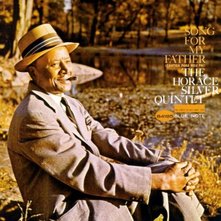|
Horace Silver
Song for My Father The pianist and composer Horace Silver was born in 1928 and grew up in Norwalk, Connecticut, the son of a father “of Portuguese origin” and a mother “of Irish and Negro descent,” as Silver recalls. The father, John Tavares Silver (born Silva), came from the island of Maio, one of the Cape Verde Islands. From these beginnings, Horace Silver went on to become one of the most influential jazz musicians of his time: one of the founders of hard bop, a pioneer of the quintet formed by tenor sax and trumpet plus rhythm section, a mentor to young jazz players, and of course a highly successful composer/arranger. The young pianist’s first break came when he was “discovered” in Connecticut by the legendary saxophonist Stan Getz. Immensely impressed by Silver’s playing, Getz encouraged him to come to New York, to the big time. Unsure of himself, though, Silver hesitated to make such a big move before being finally convinced. He spent about a year performing and touring with Getz before settling down to a musician’s life in New York. Silver’s next move was to join with drummer Art Blakey as a co-leader of the famous Jazz Messengers. But after a couple of years, and dismayed by the rampant use of drugs in the band and the brushes with the law that resulted, the clean-living young Silver decided to move on. Soon he had formed the first iteration of the Horace Silver Quintet, using tenor saxophonist Hank Mobley, trumpeter Art Farmer, bassist Doug Watkins and drummer Louis Hayes. Over the decade, he continued to lead his quintet, while the personnel within it changed. The album Song for My Father, the best-known and most successful of Silver’s recordings, was something of a cut-and-paste job, the combined product of two separate Blue Note recording sessions: one in 1963 that included saxophonist Junior Cook, trumpeter Blue Mitchell, bassist Gene Taylor and drummer Roy Brooks, the other in 1964 that included saxophonist Joe Henderson, trumpeter Carmell Jones, bassist Teddy Smith and drummer Roger Humphries. The title track, and by extension the album itself, was said to have been inspired by a trip that Silver made to Brazil, one that kindled his interest in his Portuguese roots. The album was, of course, dedicated to his father, and it features a soulful photograph of the elder Silver taken by Blue Note’s Francis Wolff. Wolff’s partner, Alfred Lion, recognized immediately the commercial appeal the new album would have and released it as soon as he possibly could, which was in January of 1965. Song for My Father is one of Blue Note's warmest, most accessible offerings, combining Silver’s simple, infectious melodies in a style that reflects the influences of bebop, gospel and rhythm ’n’ blues. One of saxophonist Joe Henderson’s earlier recordings, it offers a Henderson original (“The Kicker,” the only non-Silver composition on the album) and showcases the saxophonist’s soaring talent in a solo on the title track that is said to have stolen the show. —Terry MacDonald Track Listing: 1 Song for My Father 2 The Natives are Restless Tonight 3 Calcutta Cutie 4 Que Pasa 5 The Kicker 6 Lonely Woman 7 Sanctimonious Sam 8 Que Pasa (Trio Version) 9 Sighin’ and Cryin’ 10 Silver Threads Among the Soul Personnel 1963 Date: Horace Silver - piano Junior Cook - tenor saxophone Blue Mitchell - trumpet Gene Taylor - bass Roy Brooks - drums 1964 Date: Horace Silver - piano Joe Henderson - tenor saxophone Carmell Jones - trumpet Teddy Smith - bass Roger Humphries - drums Original Release Date: January, 1965 Rudy Van Gelder Edition: 1999-Remastered Label: Blue Note Records Sources: Bob Blumenthal’s 1999 liner notes; Wikipedia |
Copyright ©2024 Seacoast Jazz Society, All Rights Reserved



